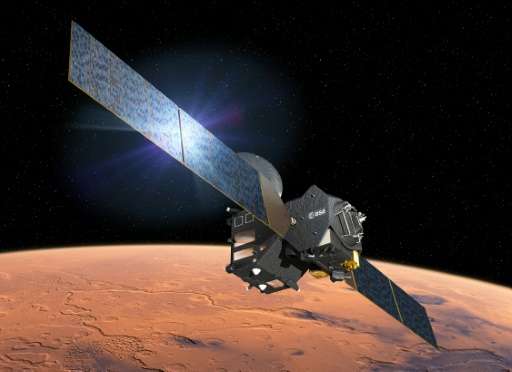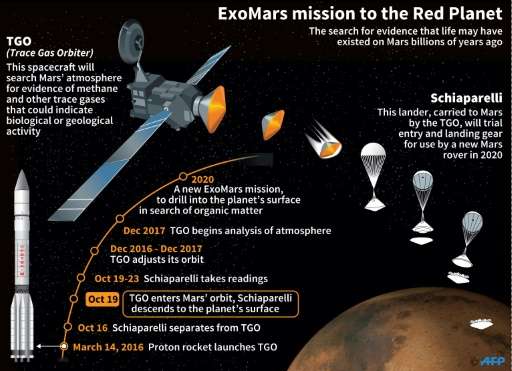Europe awaits news of Mars lander's fate

Mission controllers anxiously awaited confirmation Wednesday that a tiny European craft had landed on Mars as part of an ambitious quest with Russia to find evidence of life on the Red Planet.
The paddling pool-sized "Schiaparelli" lander was due to have ended its seven-month, 496-million-kilometre (308 million-mile) trek from Earth with a dangerous dash for the surface through the Martian atmosphere.
UPDATE: Mars probe enters atmosphere; word on landing awaited: phys.org/news/2016-10-mars-pro … re-word-awaited.html
A faint signal picked up by telescopes in India was lost around the scheduled landing time of 1448 GMT, mission scientists said—though this did not necessarily mean trouble.
The signal was never part of the official tracking of Schiaparelli—Europe's first attempt to place a lander on Mars since the British-built Beagle 2 was lost without trace 13 years ago after separating from its mothership.
"It is true that the data we have collected so far is not absolutely nominal for Schiaparelli, but that doesn't mean anything for the time being," said spacecraft operations manager Andrea Accomazzo of the European Space Agency (ESA).
"It is far too early to speculate on anything."
A signal was, meanwhile received from Schiaparelli's Trace Gas Orbiter (TGO) mothership, on its own hairy mission to enter the Red Planet's orbit.
Ground controllers applauded and hugged when the message arrived at the scheduled time, though it cannot yet be confirmed whether the TGO is in the correct orbit.
What we do know for now, is that the orbiter is "alive," Accomazzo said.
Confirmation that both the lander and orbiter manoeuvres were correctly executed is expected around 1830 GMT, when signals arrive via ESA and NASA satellites already in Mars' orbit.
Vital signs
The 600-kilogramme (1,300-pound) Schiaparelli was conceived as a Mars landing trial run for a larger and more expensive rover that will follow it to the Martian surface in a few years.

At a distance of some 170 million kilometres from Earth, it had to brake from a speed of 21,000 kilometres (13,000 miles) per hour to zero, and survive temperatures of more than 1,500 degrees Celsius (2,730 degrees Fahrenheit) generated by atmospheric drag.
Schiaparelli was equipped with a discardable, heat-protective "aeroshell" to survive the supersonic jaunt through Mars' thin, carbon dioxide-rich atmosphere.
It had a parachute and nine thrusters with which to brake its fall, and a crushable structure in its belly to cushion the final impact.
Schiaparelli had been free-falling to Mars' surface since Sunday, when it separated from the TGO, which had carried it all the way from Earth.
The test lander woke up, as scheduled, minutes before it was due to arrive at Mars' atmosphere at 1442 GMT Wednesday, the ESA said.
But after a certain point in its six-minute descent, nothing is known.
The TGO and Schiaparelli comprise phase one of the ExoMars mission through which Europe and Russia seek to join the United States in probing the hostile Martian surface.
Schiaparelli's experiences Wednesday were designed to inform technology for a rover set for launch in 2020—the second phase and high point of ExoMars.
The TGO, in turn, is charged with sniffing atmospheric gases potentially excreted by living organisms—however small or primitive.
Its science mission will only start in early 2018.
The rover, in turn, will be equipped with a drill to seek for clues of life, past or present, up to a depth of two metres under the surface.
While life is unlikely to exist on the barren, radiation-blasted surface, scientists say traces of methane in Mars' atmosphere may indicate something is stirring under the surface—possibly single-celled microbes.
Since the 1960s, more than half of US, Russian and European attempts to operate craft on the Martian surface have failed.
© 2016 AFP





















